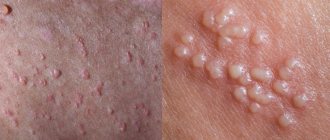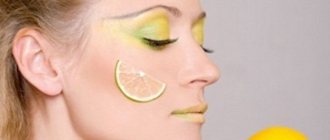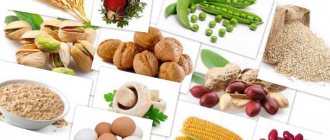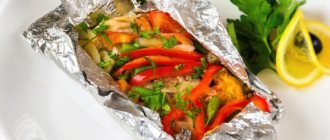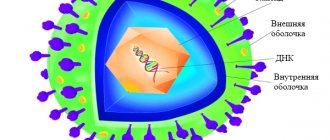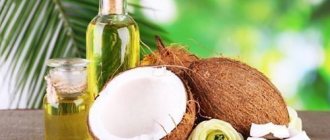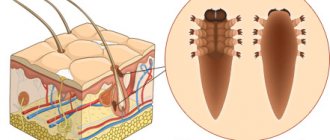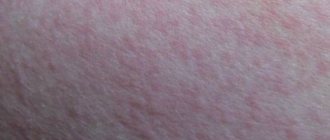Rules for hypoallergenic nutrition
To eliminate the symptoms of urticaria, it is important not only to use antihistamines in a timely manner, but also to observe the nuances of a hypoallergenic diet (a menu without allergen foods). These rules are discussed by an allergist after making a diagnosis.
Basic principles of nutrition for urticaria:
- give preference to home-cooked food. Since the composition of purchased food may not be completely indicated;
- buy products only from trusted places (without containing nitrates or chemicals that are used to give a better presentation);
- drink at least 1.5 liters of clean water per day. It promotes the removal of harmful substances and normalizes metabolic processes;
A diet for urticaria includes a healthy drinking regimen. Drinking standards for adults - do not overload the digestive tract with large portions of food;
- exclude the use of new products during the period of allergic rashes;
- minimize the consumption of junk food (fast food, fried and spicy foods);
- Avoid eating hot foods; food should be warm. Hot food increases the likelihood of developing an allergic reaction;
- the basics of the diet should consist of steamed, oven-baked or boiled dishes;
- When preparing soups with meat broth (especially chicken), the meat is boiled in 2-3 waters. Boiled fish is prepared in the same way;
- introduce new foods in small portions and evaluate the body’s reaction over the course of a week. Write down the data in a special notebook.
- the menu should be varied (but only from permitted products) and contain the necessary nutrients. Since a lack of vitamins and minerals can lead to weakened immunity and increased allergic reactions;
- once every 30 days, drink enterosorbents to cleanse the body of harmful substances;
- reduce salt intake, as it provokes swelling, which means toxic substances are retained in the body and can increase the likelihood of developing allergies;
- after a strict diet, gradually switch to a standard menu;
- do not introduce several new products at the same time. Otherwise, it is impossible to determine which food had a negative reaction on the body.
Compliance with the rules will reduce the likelihood of developing an allergic reaction, and, consequently, possible complications from it (they can be observed in acute forms of allergies).
Who should I contact?
In children, the disease often manifests itself immediately in an acute form; it is necessary to urgently call a local doctor ; if it worsens severely, call an ambulance. Allergists, dermatologists, and nutritionists treat the causes of the disorder.
It is necessary to undergo many tests to identify parasites, infections, diseases of the liver, kidneys, and gastrointestinal tract. Identify foods that cause a painful reaction. Without determining the etymology of the rash, it is impossible to prescribe the correct treatment or choose a diet. How to choose nutrition for urticaria in a child?
For this:
- after the disappearance of acute manifestations, one product is introduced into the menu;
- in case of relapse, the identified allergen is excluded from use and a break is taken for a week;
- If the new dish does not cause negative reactions, add the following.
Compatibility must : when two neutral components come into contact, they can be activated. Then urticaria will appear again in children, the diet should be tightened.
Why is it important to follow a diet for urticaria?
A diet for urticaria in adults not only helps to improve the condition, but also prevents the development of complications. The importance of diet is justified by the effect of the allergen (histamine) on the body.
Once it enters the digestive tract, the immune system recognizes the substance as a foreign object and begins to attack it. This process is accompanied by the appearance of swelling and itchy blisters.
Also, histamine can enter the body with food gradually and accumulate until the desired concentration is reached. The likelihood of accumulation increases with disruption of the digestive tract, a small amount of clean water consumed and the presence of “junk” food in the diet.
Taking antihistamines will only provide temporary improvement, since the pathogen is not eliminated.
Dietary nutrition helps cleanse the body of histamine. And increases the likelihood of complete elimination of symptoms without the use of medications. The danger of an allergic reaction lies in the likelihood of developing swelling of internal organs and tissues, which can lead to death.
When to sound the alarm?
It is impossible not to notice the manifestations of nettle fever.
Redness and then blisters appear on the child's skin. Rashes appear in the folds of the skin, on the lips, and in places of close contact with clothing. The body itches a lot, hence another name for it - infant pruritus .
Often parents do not pay attention to this.
Moreover, the rash usually disappears after a few hours , but soon appears in a new place.
There is no need to panic, but you should see a doctor as soon as possible.
Types of hypoallergenic diets
To alleviate the condition of urticaria, a specialist prescribes a suitable diet of 3 types of hypoallergenic diets.
Types of diets and their features:
- nonspecific. Only major allergenic products are excluded from the menu. Also, the diet should not contain salty, fried and spicy foods. The diet allows you to reduce the concentration of histamine with minimal changes in the menu. This nutrition program is suitable for all types of allergic reactions;
- elimination. Suitable for patients in whom the causative agent of urticaria has been identified. When creating a menu, it is enough to exclude identified “dangerous” products. It is important not only to avoid consuming the allergen in its pure form, but also in dishes where it is used as a component;
- basic. Prescribed if the allergen has not been identified. All dishes and products that can cause the development of urticaria are completely excluded from the menu.
After choosing the type of diet, the allergist gives a list of allowed foods and strictly prohibited ones. Helps to draw up a rough menu plan, and also discusses the minimum and maximum period of stay on a special diet. You can adjust your diet (especially in acute forms of allergies) only together with a specialist.
Water balance
It is recommended to drink purified or still mineral water an hour before meals 4 times a day.
We figured out what children can eat if they have hives, but what they shouldn’t drink is:
- freshly squeezed undiluted juices;
- nectars;
- strong black tea;
- strong green tea;
- cocoa;
- soda of all types;
- coffee.
We recommend weak tea without fruit or herbal additives. You can sweeten your tea with fructose. Black tea is preferred, but if no allergen is identified, green tea is brewed.
Fruit drinks and compotes are cooked following the basic rules - cook only from neutral fruits.
Important ! Bananas do not cause allergies even in infants. Their presence in the diet normalizes the intestinal microflora , promotes the rapid absorption of nutrients, the accumulation of calcium in the body, and the production of serotonin.
When a child has urticaria, the diet should contain banana (if there is no individual intolerance).
Table of permitted and prohibited products
A diet for urticaria in adults consists of including permitted foods in the diet and completely excluding prohibited ones.
Standard table for a patient with an unidentified allergen:
| Allowed foods and dishes made from them | Prohibited foods and dishes, reasons for the ban | ||
| Lean meat | Boiled and baked and for making broth | Fatty meat fillet and lard | Products overload the organs of the digestive tract, provoking the development of an allergic reaction. |
| Buckwheat, millet and oatmeal | Boiled in soups and porridges | Butter, fat, margarine | |
| Vegetables, fruits and berries (except for red and orange varieties) | Fresh, boiled, baked. The berries can be boiled into compotes or consumed dried. | Fried, salted or smoked foods | Dishes provoke stagnation of fluid in the body, which increases the likelihood of hives. Spices used may also be allergens. |
| Fresh greens and herbs (dill sprigs, mint, lettuce) | Add to salads or make medicinal decoctions | Fish, especially fatty varieties and other seafood products | Fish fillet is an allergen |
| Whole wheat flour | For making bread, cookies and other baked goods, as well as pasta from it | Sausages | Dyes and preservatives that provoke an allergic reaction are used for their preparation. |
| Dairy and fermented milk products without dyes and food additives (low fat content) | Eat fresh or use for cooking (porridge, soups, baked goods) | Red or orange vegetables, berries and fruits | The red and orange pigment contained in these products is a strong allergen |
| Refined vegetable oil | For dressing salads | Exotic fruits and citrus fruits | Fruits and vegetables not native to a person’s region of residence often become a source of allergies |
| Green or weak black tea and mineral water | Serve warm | Wheat flour of the highest and first grades | Products contribute to weight gain, and extra pounds increase the likelihood of developing allergies. |
| Bananas | Fresh. Use dried with caution | Dairy products with high fat content | |
| Semolina and mushrooms | Products are strong allergens | ||
| Alcohol products | May contain allergens, and also promotes increased blood flow, and therefore an increase in allergic reaction | ||
| Sweets, chocolates and carbonated drinks | Contains preservative allergens | ||
| Chicken eggs, honey and nuts | Strongest allergens | ||
| Coffee, strong tea | Provoke the activity of nerve cells and can cause hives as a result of overexcitation of the nervous system | ||
| Hot and spicy spices | They are allergens and contribute to fluid stagnation in the body | ||
| Meat by-products | In them, unlike meat fillet, toxins could be deposited, which could provoke the development of an allergic reaction. | ||
Sometimes an allergic reaction can also occur to permitted products, so it is important that the list of prohibitions is drawn up by a doctor individually, after an examination.
What is possible
Depends on whether the cause of the disease is found. For the first day or two, it is better to fast and limit yourself to drinking plenty of fluids. If this is an allergy, the found product is excluded and then used in cooking:
- fermented milk products, preferably home-made;
- boiled or stewed vegetables;
- cereals, preferably limited to buckwheat, rice and corn grits, semolina is strictly prohibited (adults are allowed);
- boiled or stewed meat - chicken breast, turkey, rabbit, and rarely beef;
- some fruits, mostly green and yellow, most often green apples, pears, cherries, maybe bananas;
- drink clean water, unsweetened green tea, unsweetened jelly and decoctions of dried fruits.
An example menu in this case might look like this:
- Breakfast: a glass of kefir and a portion of corn porridge.
- Second breakfast: fruit.
- Dinner. Soup with meat and vegetables.
- Afternoon snack: not sweet jelly.
- Dinner: buckwheat porridge with steamed fish cutlets.
But the allergen may not be detected immediately. In this case, you will have to follow a more strict diet that excludes meat and fish products completely. In this case, the menu for the day is compiled as follows:
- Breakfast: cottage cheese, rice porridge and tea.
- Second breakfast: low-fat yogurt.
- Lunch: mashed potatoes (pre-soaked potatoes), white cabbage salad.
- Afternoon snack: tea with crackers.
- Dinner: baked zucchini.
With chronic urticaria, you will have to consider a few more points:
- you need vitamin B12, which can be obtained from poultry meat and whole grain cereals;
- it is important to get a lot of antioxidants, which contain blueberries, raspberries, green tea;
- you need zinc (potatoes and celery);
- increase the amount of omega-3 acid (flax seeds, sea fish and soy);
- reduce the amount of vegetable fats in food due to omega-6 acids.
But after identifying the allergenic factor, you can consume almost all products that are not on the prohibited list. Naturally, adhering to the principle of eating in small quantities and often.
Of course, an individual menu is used for infants, depending on age and the number of products introduced. But the main principles remain the same.
Features of the diet for acute urticaria
In the case of acute manifestations of urticaria, the causative agent of the reaction is not difficult to identify, since the rash forms immediately after consuming allergenic foods. But to alleviate the condition, it is important not only to exclude “dangerous” foods, but to lighten the diet to restore the body’s activity.
During the period of exacerbation it is required:
- Avoid fried, salted and smoked foods. It overloads the digestive tract and traps allergens in the body;
- sweets and carbonated drinks are also prohibited;
- products and dishes should be easily digestible (boiled, baked);
- Boil meat in 2-3 waters. And soak cereals and potatoes before cooking;
- The use of kefir (low-fat and without additives) is encouraged. To restore intestinal activity and accelerate the removal of allergens;
- ensure sufficient intake of healthy proteins and fats. Otherwise, the body may become exhausted and the allergic reaction may increase;
- Drink a sufficient amount of clean water (at least 2 liters) to quickly remove the allergen.
For acute urticaria, specialists prescribe an elimination diet, in compliance with the above rules. On the first day, complete refusal of food is possible, especially if there is a high probability of complications. The transition to the regular menu should be gradual and no earlier than after 10 days.
Recommended Products
While following a hypoallergenic diet, patients can consume the following foods:
- Any porridge with the exception of semolina.
- Durum pasta.
- Vegetables and fruits of dull color:
- Lean meat: rabbit,
- chicken,
- turkey,
- beef.
Photo gallery: hypoallergenic diet products
Dietary features for chronic urticaria
For chronic urticaria, a nonspecific diet is generally prescribed, which can last up to 6 months in adults (in children up to 3 months).
Diet for chronic allergies (promotes not only the removal of the allergen, but also the normalization of the functioning of the gastrointestinal tract):
- the menu should consist only of products that are allowed for consumption (listed in the table above);
- semi-finished and ready-made meals from stores are excluded;
- drink up to 1.5 liters of clean water per day;
- the amount of salt used is kept to a minimum;
- eat more foods containing fiber to cleanse the intestines of waste, toxins and allergens;
- portions should be small. Then the food eaten will be completely digested and quickly eliminated from the body;
- take vitamin complexes to strengthen the immune system;
- If necessary, the body is cleansed with sorbents and enemas.
If complications are likely to develop, a basic diet may be prescribed (for 14 days). Next, allergen products are gradually introduced, and the body's reaction to them is monitored.
Hives
General description of the disease
Urticaria is a human skin disease in the form of rashes, which are mainly allergic in nature and look like blisters that appear after touching nettles.
The main causes of urticaria:
- exogenous in nature - the impact of thermal, physical, chemical, mechanical, pharmacological factors and food products on the human body causes urticaria of this type;
- endogenous - urticaria occurs against the background of diseases of the gastrointestinal tract, liver, central nervous system and other internal organs.
- In addition, the cause of urticaria can be the bites of bees, gadflies, wasps, jellyfish and the bites of insects belonging to the group of blood-sucking insects (midges, fleas, mosquitoes, mosquitoes).
Types of urticaria and its symptoms:
- 1 Acute form - the sudden and rapid appearance of red round blisters, which have a matte tint in the center and are edged with a red border at the edge. The rashes can grow together, forming large, swollen red spots that are very itchy and itchy. In this case, the patient gets severe chills and the temperature rises sharply. This phenomenon is called "nettle fever". Basically, blisters appear on the torso, buttocks, and upper extremities, but rashes can also affect the mucous membranes of the lips, tongue, nasopharynx and larynx, which makes it difficult for the patient to breathe and eat.
The acute form of urticaria not only appears quickly, but also quickly disappears (in about an hour and a half, rarely within several days). This form appears as a consequence of food or drug allergies in the form of a protective and response reaction to eating food with allergens, blood transfusions, and vaccinations. This is a typical variation of this form.
In addition to it, there is an atypical course of acute form of urticaria. Its distinctive feature is the appearance of an oblong (linear) rash that does not itch. The cause of the appearance is considered to be mechanical damage to the skin.
Medical workers also include angioedema or giant urticaria as an acute form of urticaria. At the site of the lesion, the skin becomes swollen, dense, but at the same time elastic. It has a white color, in rare cases a light pink tint. The mucous membranes and subcutaneous fat layer are affected. In most cases, there is no itching or burning, and swelling disappears within a couple of hours. Swelling may recur. If the hives are located in the larynx, suffocation or stenosis may develop. If the swelling is located in the area of the eye sockets, then the eyeball may deviate, which may result in decreased vision.
- 2 Recurrent chronic form - the cause is the presence in the body of chronic infections that arise due to tonsillitis, caries, adnexitis. The reasons include disruption of the gastrointestinal tract, liver, and intestines. The rash appears in the form of attacks and is not as widespread as in the acute form. It can last for several weeks, months and even years. Accompanying symptoms: weakness, joint pain and severe headache, itching in areas of the rash, diarrhea, nausea, gag reflexes. With prolonged continuation of urticaria, the patient develops nervous disorders that appear from insomnia due to severe and continuous itching and burning.
- 3 Persistent papular form - chronic rashes develop into the papular stage of urticaria, in which red or brown nodules appear. Basically, the skin of the extremities in the flexion-extension parts is affected. Women are more likely to transition from chronic to papular urticaria.
- 4 Solar form - a rash appears on exposed parts of the body that are exposed to sunlight. It is seasonal. The disease progresses in spring and summer, when the sun is most active. Such rashes appear in people with liver diseases whose porphyrin metabolism is impaired. This type of urticaria predominantly affects females.
A few simple recipes for every day
After making a diagnosis, the allergist prescribes an individual list of products allowed and not allowed for consumption (depending on whether the allergen is identified or not).
Using this list, an approximate menu of dishes for the week is compiled. The following are recipes that can be used in dietary nutrition. They do not cause allergies, but replenish the body with essential nutrients.
First meal
The diet for urticaria in adults primarily includes soups in the daily diet. They do not overload the digestive tract and quickly saturate the body.
Soup recipes with descriptions of their preparation:
| Ingredients used | Step-by-step preparation | Nuances of the dish |
| Potato soup | ||
| 1. Peel the onion and cut into medium size. Lightly fry in olive oil. 2. Peel the potatoes, cut the middles into cubes and add to the onion and fry for another 5 minutes. 3. Place the roast in a container for cooking soup and add water and salt. 4. Cook until the potatoes are softened. 5. Grind using a blender. And add chopped dill sprigs. 6. Bring to a boil and remove from heat. | When cooking, instead of water, you can use light meat broth and permitted vegetables. They are also lightly fried beforehand. |
| Vegetable puree soup with croutons | ||
| 1. Peel potatoes and pumpkin. 2. Cut the vegetables into medium-sized cubes. 3. Boil the broth and add vegetables (potatoes, pumpkin, peas) to it. Boil until softened. 4. Grind the ingredients with a blender. Add chopped dill. Let it boil and remove from heat. 5. Cut the bread pieces into 1 cm cubes and dry in the oven. Serve with prepared soup. | Pumpkin can be replaced with zucchini or cabbage. You can also add chopped pieces of boiled meat to the soup to increase nutritional value and satiety. |
| Vegetable noodle soup | ||
| 1. Place parsley root, peeled carrots and onion into boiling water. Boil until softened. 2. Remove vegetables from the broth and chop with a blender. 3. For further preparation, you can use ready-made vegetable or meat broth. 4. Place the vegetable mixture in the broth and add the potatoes cut into cubes. 5. Cook for 10 minutes. 6. Add table salt and noodles. Cook for another 10 minutes. 7. 1 minute before turning off, add chopped dill sprigs and parsley. | The duration of cooking potatoes and noodles depends on the size of the ingredients. |
Consume soups warm. It is recommended to cook in small portions so that the dish is fresh every time. Then it contains more nutrients.
Second courses
Main courses for allergies allow you to compensate for the lack of protein and fat in the body and relieve hunger for a long time.
Options for preparing second courses:
| Main components | Cooking process | Nuances of the dish |
| Cheese sauce with pasta | ||
| 1. Grate the cheese and mix with cream. 2. Place the butter in a container and pour the cream cheese mixture into it. 3. Simmer until the cheese pieces are completely dissolved. 4. Boil pasta in the standard way. 5. Rinse and pour sauce over it. | Pasta can be replaced with boiled potatoes and porridge. In addition, you can use boiled meat. |
| Baked fish with vegetables | ||
| 1. Cut the zucchini into slices. 2. Separate the cabbage into inflorescences. 3. Beat the fish fillet and sprinkle with salt. 4. Place the meat on foil. Place zucchini slices and cabbage inflorescences on top. Seal. 5. Bake at 180 degrees for 25 minutes. 6. Once ready, let the dish stand in the oven for 10 minutes. 7. When serving, garnish with chopped parsley. | This method can be used to cook chicken or other low-fat varieties. You can place onion slices on the bottom of the foil (under the meat fillet). They will add a special taste and aroma to the dish. |
| Baked vegetables | ||
| 1. Peel the potatoes and cut into 0.5 cm slices. 2. Peel the onions and cut into rounds. 3. Pour salted boiling water over the cabbage to remove bitterness. 4. Grate the cheese on a grater with small holes. 5. Place ½ of the potatoes in a container. 6. Next, put onion rings. 7. To avoid dryness, sprinkle the layer with olive oil. 8. Place the remaining potatoes on top of the onions. 9. Place the final layer of cabbage inflorescences and sprinkle with cheese. 10. Bake at 180 degrees for 30 minutes. | Between layers of potatoes you can place cubes of lean meat soaked in kefir. |
The main courses will be more aromatic and tastier if they stand for 15 minutes after cooking.
Salads and snacks
A diet for urticaria in adults requires the mandatory daily consumption of fresh salads to replenish the level of vitamins and minerals in the body, as well as to normalize the functioning of the digestive tract.
To prepare salads, not only permitted fresh vegetables are used, but also fruits and berries.
Recipes for hypoallergenic salads:
| Components used | Rules for preparation and serving | Nuances of dishes |
| A fresh vegetable salad | ||
The number of components is at the discretion of the cook. | 1. Finely chop the cabbage and mash with a masher or your hands. 2. Cut the cucumber into cubes or small strips. 3. Remove the peas from the pods. 4. Combine the ingredients with the addition of salt and oil. Mix. 5. Garnish with chopped dill sprigs. | When preparing a salad, it is important to choose vegetables without nitrates and fresh. |
| Boiled vegetable salad | ||
| 1. Boil potatoes and carrots and peel them. Let cool. 2. Cut potatoes and boiled meat into medium cubes. 3. Boiled carrots and cucumber cut into small cubes. 4. Finely chop the dill sprigs and peeled onion. 5. Combine ingredients, add salt and oil. Mix. | If you do not plan to eat the salad right away, then salt and oil are added before serving. |
| Fruit and berry salad | ||
| 1. Peel the bananas and cut into rings. 2. Core the pear and apple and cut into small cubes. 3. Peel the kiwi and cut into half rings. 4. Remove the grape berries from the branch; 5. Mix the ingredients carefully. 6. Shake the yogurt and add to the fruit. Mix carefully. | When preparing a salad, you need to thoroughly wash the fruits, since they are used in the salad along with the peel. |
As snacks, you can prepare canapés and sandwiches from permitted products.
Cooking options:
| Ingredients | Preparation |
The number of components is determined independently | 1. Cut the ingredients into cubes or circles of equal thickness. 2. Thread the ingredients onto a skewer in the following order:
|
The proportions are taken arbitrarily. | 1. Cut the bread into triangular pieces. 2. Cut the meat and cheese into thin slices. 3. Finely chop the dill. 4. Place meat, cheese on bread and sprinkle with herbs. 5. Place in the microwave for 1 minute. |
It is advisable to consume salads and snacks immediately. Otherwise, the vegetables will yield juice and the dishes will lose their appearance.
Dessert
The following dishes can be consumed as desserts:
| Components | Preparation |
| Cheese casserole | |
| 1. Mix sour cream with cottage cheese. 2. Combine granulated sugar with rice flour and add to the curd mass. 3. Mix the ingredients and add slaked soda with vinegar. 4. Mix again and place in a baking container. 5. Bake at 180 degrees for 40 minutes. |
| Homemade yogurt. | |
| Mix low-fat kefir with applesauce, banana or kiwi. The taste of the dessert is chosen individually. The proportions of ingredients should be 5:1. | |
| Fruit snack | |
The number of components and their type are chosen arbitrarily. | 1. Berries and fruits are washed. Chop if necessary. 2. Combine selected berries and fruits and pour yogurt/kefir. 3. Use without stirring. |
Desserts allow you to satisfy your hunger in the evening without overloading your digestive tract.
Beverages
For urticaria, it is important to drink at least 1.5 liters of clean water per day.
To quench your thirst you can consume:
- green teas (you can prepare your own from fresh herbs);
- compotes and jelly from fresh and dried fruits and berries (only those allowed);
- fresh juices (it is recommended to prepare your own, as store-bought juices contain preservatives).
For urticaria, dietary nutrition and drinking regimen are prescribed by the treating specialist. Since, depending on the form of the allergy and the type of pathogen, the list of permitted and prohibited products changes. You can adjust your diet only in consultation with your doctor. If you follow the rules of nutrition, the pathology can be stopped in both adults and children.
Author: Kotlyachkova Svetlana
Article design: Mila Friedan
Approximate menu for the week
Diet for urticaria is an important issue for a child. It is necessary to completely eliminate foods that may cause allergies. The diet must contain hypoallergenic or neutral products.
We present to your attention a weekly menu, what a child can eat with hives.
Monday
Breakfast : corn porridge, kefir.
Lunch : banana.
Lunch : chicken soup, oatmeal cutlets, unsweetened tea with a bagel.
Afternoon snack : rice pudding, tea.
Dinner : buckwheat porridge with fish balls, tea, crispbread.
Tuesday
Breakfast : rice porridge, tea with biscuits.
Lunch : mashed green apple.
Lunch : vegetable broth, fresh cabbage salad, boiled chicken, prune compote.
Afternoon snack : pumpkin curd, tea.
Dinner : baked potatoes with steamed sole, tea with homemade oatmeal cookies.
Wednesday
Breakfast : corn porridge, green tea with crackers.
Lunch : yogurt, green apple.
Lunch : pumpkin soup, turkey cutlets, green salad, tea.
Afternoon snack : baked green apples.
Dinner : pasta with apple sauce with steamed meatballs, green tea.
Thursday
Breakfast : oatmeal porridge, tea, biscuits.
Lunch : baked yellow or green apple
Lunch : fresh cabbage soup, vegetable stew with chicken, tea.
Afternoon snack : unsweetened tea, bread.
Dinner : mashed potatoes with meatballs, unsweetened tea
Friday
Breakfast : pearl barley porridge, tea.
Lunch : acidophilus.
Lunch : cucumber salad, cauliflower soup with rolled oats, tea.
Afternoon snack : cottage cheese casserole, apple compote.
Dinner : stewed spinach, chicken in sour cream, tea
Saturday
Breakfast : zucchini casserole, green tea with dried bread.
Lunch : yellow cherry or green apple.
Lunch : vegetable broth with rice balls, fruit juice or tea.
Afternoon snack : Kefir jelly (Mix kefir with sugar, natural yogurt, gelatin, refrigerate until frozen).
Dinner : baked cod with green beans, jelly or tea.
Sunday
Breakfast : buckwheat porridge with water, mild cheese, green tea.
Lunch : cottage cheese with grated apple.
Lunch : chicken soup with broccoli and zucchini, unsweetened tea.
Afternoon snack : acidophilus.
Dinner : buckwheat casserole with chicken, compote or tea.
